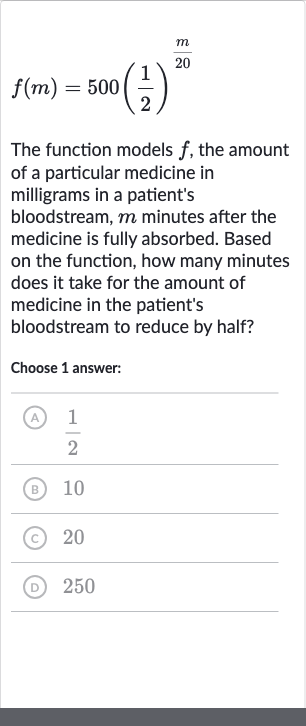AI tutor
Welcome to Bytelearn!
Let’s check out your problem:

The function models , the amount of a particular medicine in milligrams in a patient's bloodstream, minutes after the medicine is fully absorbed. Based on the function, how many minutes does it take for the amount of medicine in the patient's bloodstream to reduce by half?Choose answer:(A) (B) (C) (D)
Full solution
Q. The function models , the amount of a particular medicine in milligrams in a patient's bloodstream, minutes after the medicine is fully absorbed. Based on the function, how many minutes does it take for the amount of medicine in the patient's bloodstream to reduce by half?Choose answer:(A) (B) (C) (D)
- Given function: We are given the function , which models the amount of medicine in a patient's bloodstream minutes after the medicine is fully absorbed. We want to find the value of that makes half of the initial amount, which is mg.
- Finding half of initial amount: To reduce the amount of medicine by half, we need to find such that . This means we are looking for when equals mg, since .
- Setting up the equation: Setting up the equation, we have . To solve for , we can divide both sides of the equation by to isolate the exponential term.
- Simplifying the equation: After dividing by , we get , which simplifies to .
- Setting exponents equal: Since the bases are the same on both sides of the equation, we can set the exponents equal to each other. This gives us .
- Solving for m: Multiplying both sides of the equation by to solve for , we get , which simplifies to .
More problems from Compare linear and exponential growth
QuestionGet tutor help
QuestionGet tutor help
QuestionGet tutor help
QuestionGet tutor help
QuestionGet tutor help
QuestionGet tutor help
QuestionGet tutor help
